Château Gloria
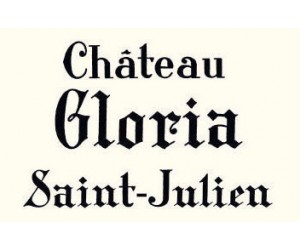
The Estate
Formed in 1903 by Henri Martin, Chateau Gloria is a relative newcomer to Saint-Julien – especially compared to its well-established peers in the region. This 50-hectare vineyard was assembled piece-by-piece over a number of years, through the purchase of grand cru plots classified in 1855. Today, the estate is managed by Jean Louis Triaud who also manages the sister estate, Château Saint-Pierre.

Château Gloria Saint-Julien
Location: In the center of Beychevelle, to the west and to the north of the appellation (bordering Pauillac).
Appellation: AOC Saint-Julien
Surface Area: 50 hectares
Average Age of the Vines: About 40 years old
Grape Varieties: 65% Cabernet Sauvignon, 25% Merlot, 5% Cabernet Franc, 5% Petit Verdot (percentages change depending on the vintage)
Soil: Gunzian gravel on a clayey-sandy subsoil
Harvest: Manual
Vinification: Traditional method used for the production of exceptional wines to be aged for a long time. Stainless steel vats with thermoregulation.
Aging: 14 months in casks, an average of 40% of which are replaced
2018 Reviews:
“This wine has all the structured intensity and ripe fruitiness of a Saint-Julien. At the same time, it displays a light touch with the black fruits and open texture, promising an attractive wine. Drink the wine from 2026.” – 94pts, Wine Enthusiast
“Fresh and energetic, with violet, licorice and cassis aromas and flavors spilling forth while bramble and graphite run underneath. Applewood streak gives the finish some spine. Cabernet Sauvignon, Merlot, Petit Verdot and Cabernet Franc.” – 93pts, Wine Spectator
2017 Reviews:
“An attractive, immediately fruity wine, this also has good tannins. Enticing blackberry flavors give richness as well as freshness. This wine will develop quickly, so drink from 2023.” – 93pts, Wine Enthusiast
Château Grand-Puy Ducasse
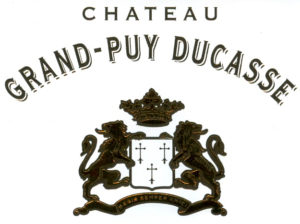
The Estate
In the middle of the 17th century, Arnaud Ducasse bought a small house on the banks of the Gironde estuary from Jacques de Ségur, Seigneur of Lafite. He could hardly have imagined then that it would be the start of a superb estate that would remain in his family for almost 3 centuries.
Pierre Ducasse, a lawyer passionate about vine-growing, is the real founder of the estate. He bought land within 3 parishes–Pauillac, Saint-Lambert, and Saint-Sauveur–as well as 3 Lord’s domains–Lafite, Latour, and Beychevelle. Additional purchases and swaps enabled him to increase his estates up to his death in 1797.
His son inherited the 60-hectare estate (148 acres), then called “Ducasse-Grand-Puy-Artigues-Arnaud”, of which two-thirds were planted with vines. Around 1820, he had the existing château built, on the site of his ancestors’ house, facing the Gironde estuary. It was under his son-in-law’s management, Adrien Chauvet, that the estate was classified in 1855, under the name of Artigues Arnaud. The company called Grand-Puy Ducasse was then founded in 1932.
In 1971 a new group of shareholders took on the somewhat dormant estate and went on to restructure and enlarge the vineyard’s holding. As from 1980, the winery was equipped with a new vatting house, including sorting tables and other facilities for handling the harvest. In 1991, the sorting tables were moved into the vineyards, in order to improve the quality of hand-picking. In 2004, CA Grands Crus, a subsidiary of the Groupe Crédit Agricole, acquired Château Grand Puy Ducasse. An improvement plan was put together for the entire estate. It is supervised today by Anne Le Naour, the Technical Director, and the consultant oenologist, Hubert de Bouärd.

Château Grand-Puy Ducasse Pauillac 5ème Grand Cru Classé
Appellation: Pauillac, Grand Cru Classé en 1855
Terroir: Garonne gravels and silica, typical of Pauillac, for the Cabernet Sauvignon, and sandy gravels for the Merlot.
Production Area: 40 ha
Plant Density: 10,000 Vines / ha
Average Age of the Vines: 30 years
Viticulture: Parcel management of soil and vineyard.
Harvest: After hand-picking and selection of the grapes on the vines, they are de-stalked and carefully sorted once more.
Vinification: Fermentation is carried out in temperature controlled stainless-steel tanks.
Aging: After blending, the wine is aged from 18 to 24 months in French oak barrels, 30% to 40% of which are new.
Production: 100,000 bottles
Grape Varieties: Cabernet Sauvignon, Merlot (percentage vary depending on the vintage)
Tasting Notes: Perfectly balanced wine, with a lovely acidity that makes the wine fresh and enticing, long length; lovely ripen tannins round and well concentrated; strong notes of fruits on the palate. Powerful wine with finesse and elegance. A Wine perfect for aging.
2005 Reviews: “Another “best ever” performance, the Grand-Puy-Ducasse is made in a charming style for a 2005 Pauillac. This deep ruby-hued, very concentrated, precocious, showy effort displays copious quantities of sweet oak intermixed with black cherries, black currants, velvety tannins, medium body, and loads of fruit.” – 91pts, Robert Parker
Château Grand-Puy-Lacoste
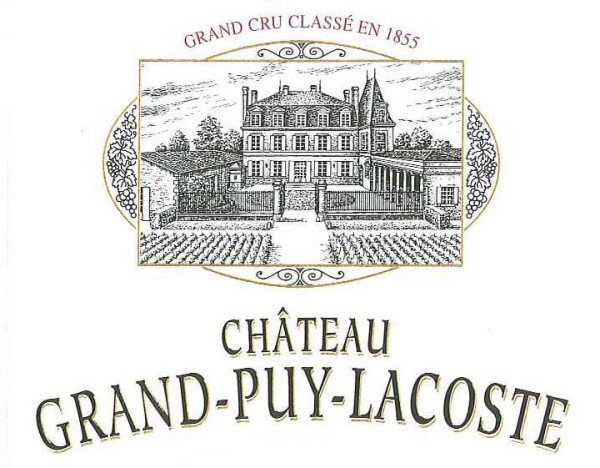
The Estate
Chateau Grand-Puy-Lacoste is a 90 hectare estate located in the terroir of Pauillac, one of the eight appellations of Médoc, on the left bank of the estuary of the Gironde. Puy, the old French word for “plateau,” refers to the flatter part of the terrain that rises to a height of about 20 meters above sea level. This particular terroir is ideal for wine production for several reasons, including a temperate climate, nutrient rich soil, and inhabitants who are skilled in the art of winemaking.
The Vines
The vines are divided into the following grape varietals: 75% Cabernet Sauvignon, 20% Merlot , and 5% Cabernet Franc. They are planted at a density of 10,000 vines/ha, with an average age of 38 years. The winemakers at Grand-Puy-Lacoste are committed to limiting the use of chemical treatments on their vines, and have not used insecticides or herbicides for the past 10 years.
The Soil
The soil here is incredibly rich in nutrients, and is composed of alluvial stones which allow for excellent drainage for water. Additionally, this gravelly soil absorbs heat during the day, releasing it to the vines overnight, allowing for even ripening of the grapes. Between the rows of vines, the soil is plowed to control surface vegetation as well as to remove the superficial roots, encouraging the vines to drink deep, and the use of sprays by vineyard manager Marc Duvocelle is described as the “minimum effective.”
Vinification
As might be expected, harvest is manual, the fruit going over a sorting table before being destemmed, followed by a second sorting in advance of the fermentation in stainless-steel and are temperature-controlled.. There is a three-week maceration before the wine does into oak for up to twenty months, using barrels perhaps up to 70% new each vintage.
Wines & Production
The grand vin is Château Grand-Puy-Lacoste, of which there are up to 18,000 cases per annum, and there is a second wine, Lacoste-Borie.
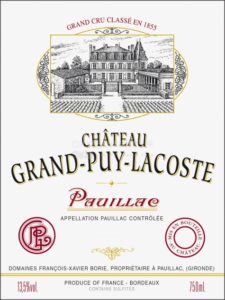
Château Grand-Puy-Lacoste
Production Area: 55 out of 90 hectares
Average Age of the Vines: 38 years old
Grape Varieties: Cabernet Sauvignon, Merlot, Cabernet Franc (varying percentages dependent on the vintage)
Soil: Very deep coarse gravel
Plantation Density: 10,000 vines per hectare
Root Stock: Riparia gloire & 101.14
Vines: Mechanical ploughing of the soil. Spraying kept to the absolute effective minimum.
Harvest: Hand-picked. Two successive selections before and after the de-stemming process.
Vinification: A long period of maceration (about 3 weeks)
Aging: 16-18 months in French oak barrels (75% new barrels each vintage).
Tasting Notes: Grand-Puy-Lacoste owes its structure and style to a significant majority of Cabernet Sauvignon which reflects the richness and potential of our terroir. Its color is a deep and intense red. The bouquet releases the typical aromas of black fruits and blackcurrant with added spices. The attack on the palate is pronounced, showing a structure that is both elegant and balanced. All together the wine allies finesse, freshness and persistence. We find this wine very much in the idiom of the fine vintages of Grand-Puy-Lacoste where elegance aligns with tannins which are both ripe and suave.
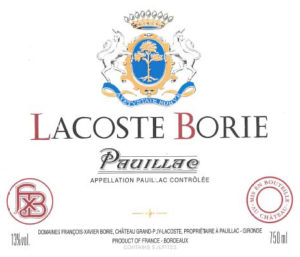
Lacoste-Borie
Grape Varieties: Cabernet Sauvignon, Merlot, Cabernet Franc (varying percentages dependent on the vintage)
Production Area: 55 in 1 block around the Chateau
Average Age of the Vines: 38 years old
Soil: Very deep coarse gravel
Plantation Density: 10,000 vines per hectare
Root Stock: Riparia gloire & 101.14
Vines: Mechanical ploughing of the soil. Spraying kept to the absolute effective minimum.
Harvest: Hand-picked. Two successive selections before and after the de-stemming process.
Vinification: A long period of maceration (about 3 weeks)
Ageing: 14-16 months in French oak barrels (45% new barrels each vintage)
Tasting Notes: The Lacoste Borie presents a nice ruby red color. It is a medium-bodied wine with a well-developed, ripe fruity, spicy, toasty and iron-scented bouquet. The flavors are soft, savory and round. The palate presents a beautiful structure supported by charming tannins.
Château Grange-Neuve
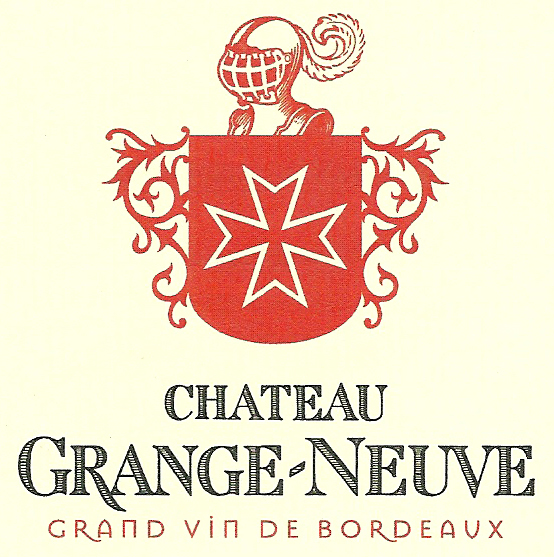
The Estate
Formerly part of the estate of Bourgneuf, the first mention of Château Grange-Neuve was at the end of the 19th century by the grandfather of the current owners. Over time the vineyard has been enlarged and today it spans 12 hectares situated on the west side of Pomerol. The soil consists of silica on the surface and iron underneath (called “crasse de fer”) which is very typical of the terroir of Pomerol. The entire vineyard was replanted following the great frost of 1956. Chateau Grange-Neuve is surrounded by Chateau Latour, Chateau Bourgneuf, and Chateau La Pointe.

Château Grange-Neuve Pomerol
Owner: Jean-Marie Gros
Appellation: Pomerol
Soil: Iron, gravel, and silica
Production Area: 12 ha (30 acres)
Age of the Vineyard: 35 years old
Annual Production: 300,000 bottles
Grapes Varieties: 95% Merlot, 5% Cabernet Franc
Vinification: Manual harvesting and de-stemming of the entire crop. Vatted for 1 month, with frequent pumping over. The wines are clarified naturally and matured in barrels (33% are new). Aging in barrels will take 12 to 18 months, before the wines are again returned to vats for egg-white fining before bottling.
Tasting Notes: Beautiful balance between elegance and power. Excellent Merlot qualities with delicate tannins and hints of red fruit and truffles. Drink now or keep for years.
Château Gréteau Medeville (Sustainable)
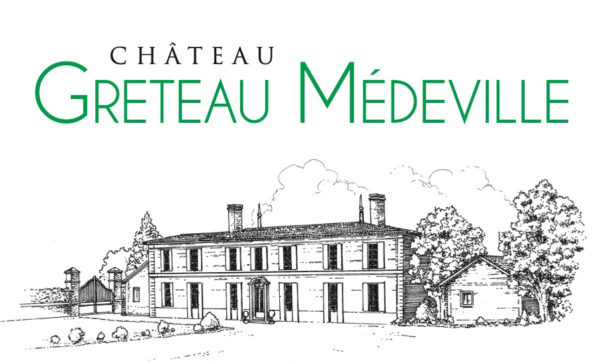
The Estate
Dating back to the 17th century, Gréteau’s noble house was originally a hunting lodge owned by the Duke of Epernon. Situated on the right side of the Garonne River, the 9-hectare estate has a limestone subsoil, clay and limestone sloping terroir, and is planted mainly with Semillon and Sauvignon grapes.
Owner: Famille Medeville & Fils
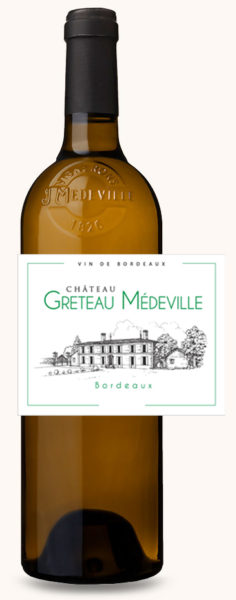
Château Gréteau Medeville Bordeaux Blanc
Production Area: 2 hectares
Soil: Clay-limestone
Average Age of the Vines: 35 years old
Viticulture: Certified Sustainable. Green field (EMS – Environmental Management Sytem – and ISO – International Standard Organization – 14001)
Harvest: Manual harvest
Vinification: After maceration and pressing, the must is settled. Controlled at low temperature during the whole fermentation, the wine is then aged on fine lees for 2 months. Bottled at the property 4-5 months after the harvest.
Annual Production: 20,000 bottles
Grape Varieties: Sauvignon Blanc, Muscadelle, Sémillon
Alcohol Content: 13.5%
Tasting Notes: Nice color, intense nose with notes of fruit. Good attack on the palate with nice acidity. Very fresh finish.
Food Pairings: Seafood, spicy foods, fresh goat cheese.
Serving Suggestion: Serve between 8-10°C
Château Gruaud-Larose (Biodynamic)
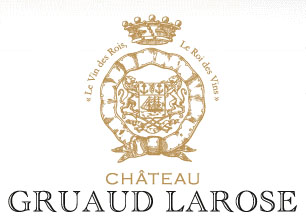
The Estate
The estate of Gruaud Larose in Saint-Julien has been divided up and joined together many times over the years. It was first owned by Joseph Stanislas Gruaud, a knight, followed by 2 other members of the Gruaud family, a judge and a priest. They combined their various properties in Bordeaux to create a 116 hectare winemaking estate which they named Fond Bedau. The judge and priest decided to bottle their own wines separately- the priest called his wine Chevalier de Gruaud, and the judge named his Abbe Gruaud.
Management of the property was handed over to Joseph Sebastian de La Rose in 1778. He added his name to the estate which was thereafter known as Gruaud Larose. In 1812, the family sold Gruaud Larose to Pierre Balguerie, Baron Jean Auguste Sarget, and David Verdonnet in order to pay off its debts. Soon after the sale, David Verdonnet died and so the estate was divided evenly between Balguerie and Sarget who managed the property together for 50 years.
Gruaud Larose was divided up yet again in 1867 and would remain separate until the 20th century. With his half of the estate, Baron Sarget bottled and sold the wine he produced under the name Gruaud Larose Sarget. He also began construction of the chateau on the property in 1875. The remaining portion of the original vineyard passed to the Bethmann family, who sold their wine under the names Gruaud Larose Faure and Gruaud Larose-Bethmann at different times.
In the early 1900s, the Cordier family acquired both the Sarget and Bethmann portions of the original estate and renamed the property Gruaud Larose once more. Jacques Merlaut, owner of Chateau La Gurgue, Haut Bages Liberal, Citran, Ferriere, and Chasse Spleen, purchased the property in 1997 and owns it to this day. Merlaut strives to make this Grand Cru Classé the most natural expression of wine by using organic compost and waste water treatment to protect and defend the grape viness.

Château Gruaud-Larose Saint-Julien 2ème Grand Cru Classé
Appellation: AOC Saint-Julien
Production Area: 82 hectares
Soil: Garonne gravel from the first quaternary, settled more than 600,000 years ago
Grape Varieties: Cabernet Sauvignon, Merlot, Petit Verdot, Cabernet Franc, Malbec
Plant Density: 8,500-10,000 vines/hectare
Average Age of the Vines: 46 years old
Viticulture: Integrated Pest Control (mechanical work, organic fertilization), Weather Station (phytosanitary protection), Prophylaxis (thinning out the leaves, removal of excess buds and shoots, green harvest). Heightening of the trellis. 100% of the surface is managed according to the principles of Organic and Biodynamic Agriculture.
Harvest: Manual harvesting, selection on a belt in the vineyard and double sorting at the harvest reception.
Vinification: Weighing of the crop, then plot selection in the tank (grape variety, terroir, age, …). The tanks are 40% wood and 60% cement (thermo-regulated tanks). Alcoholic fermentation with the addition of yeasts at temperatures between 31°C – 33°C. Daily tasting of each tank. Maceration lasts 21 – 35 days at adapted temperatures and according to the tasting. The grapes are pressed in pneumatic presses, then immediately transferred into barrels. Tasting and selection of four press wines among the barrels. Malolactic fermentation takes place 50% in barrels in a thermostatically controlled cellar, the rest in wooden tanks.
Aging: 16-18 months in French, fine grain, oak barrels, renewed by 30% every year to enhance the fruit. Medium toast.

Sarget de Gruaud-Larose Saint-Julien
Owner: Jean Merlaut
Vineyard Manager: Patrick Frédéric
Cellar Master: Philippe Carmagnac
Appellation: AOC Saint-Julien
Production Area: 82 ha/203 acres
Soil: Garonne gravel from the first quaternary, settled more than 600,000 years ago
Grape Varieties: Cabernet Sauvignon 57%, Merlot 31%, Cabernet Franc 7.5%, Petit Verdot 3%, Malbec 1.5%
Plant Density: 10,000 to 8,500 vinestocks/ha
Vineyard Management: Integrated Pest Control (mechanical work, organic fertilisation), Weather Station (phytosanitary protection), Prophylaxis (thinning out the leaves, removal of excess buds and shoots, green harvest). Heightening of the trellis. Manual harvesting, selection on a belt in the vineyard and double sorting at the harvest reception.
Average Age of the Vines: 25 years
Harvest: Weighing of the crop. Plot selection in the tank (grape variety, terroir, age…)
Vinification: In thermo-regulated tanks (60% cement, 40% wood). Yeast addition. Fermentation temperatures: 31°-33°C. Daily tasting of each tank. Pumping-over 2 volumes a day during fermentation according to tasting. Maceration for 21-35 days at adapted temperatures and according to the tasting. Running off; separation of the free-run-wine according to variety and tasting. Pneumatic presses; immediate transfer of the press wine into barrels. Tasting and selection of 3 press wines among the barrels. Malolactic fermentation, 50% in barrels in a thermostatically controlled cellar.
Aging: 14 months in French oak barrels (10% new, the rest 2-3 years old)
Alcohol: 12.7%
Total Acidity: 3.6
Tasting Notes: The color is brilliant and clear. The powerful nose reveals notes of roasting and leather. The second nose releases notes of jammy prunes. The mouth shows silky tannins, balance and freshness. Great aromatic persistency.
Château Guiraud

Overview:
History:
The “Noble House of Bayle” used to be estate’s name when it belonged to the Mons Saint-Poly family. A notary deed dated February 22, 1766 reveals that Pierre Guiraud, a Bordeaux merchant of Protestant faith, bought the estate for 53,000 pounds. On his death in 1799, his son Louis succeeded him. It was under the management of Louis Guiraud that the estate was saved from a severe devaluation which had begun in 1793, and became a famous château, well known for the quality of its wine. After Louis’ death in 1837, his son Pierre-Aman inherited a well-established property, with a value estimated at 250,00 pounds. Within a period of 80 years and after passing through the hands of three generations of winemakers, various families succeeded each other as owners of the estate. Their legacy was confirmed in 1855 when Château Guiraud became a Premier Grand Cru de Sauternes.
During a dinner in early 2006, Robert Peugeot, an industrialist, and three wine makers, Olivier Bernard of Domaine de Chevalier, Stephan Von Neipperg of Château Canon La Gaffelière, and Xavier Planty, the estate’s director, decided to buy Guiraud. They signed a purchase contract on July 20, 2006 thereby uniting their shared passion for wine, gastronomy, nature, and hunting.
The Location:
The estate is situated 45 km south of Bordeaux, on the left bank of the Garonne river, and covers an area over 128 hectares. The whole estate is located in the village of Sauternes.
The Terroir:
The vines grow on extremely heterogeneous soils and subsoils: sandy gravel makes up to 80% of the soil, with the remainder consisting of deeper layers of gravel and clay. The subsoils show variation, from translucent sand to pure gravel layers that alternate with masses of red clay, marl and limestone, calcified oyster layers, and red and white clay. Excessive rain can cause the vines to suffocate if their roots bathe in the water trapped between clay layers. To prevent this, drains are dug 60 cm deep in the ground before the new vines are planted which allows the water to flow through the drains to large ditches.
The Microclimate:
The region of Sauternes belongs to a special microclimate which explains the unique character of its wines. It is pleasant in winter, and warm and wet in spring. Summers are not too hot (20-30°C), which aids in progressive ripeness of the grapes. It is during the autumn that the climate is a bit different; it is during this season that a microscopic fungus called Botrytis cinerea or “noble rot” develops. In the morning, mists cover the vineyards, which helps the botrytis grow. With the rising of the sun, the mists vanish and the ensuing hot temperatures concentrate the flavor of the grapes. The wind also has a key role, helping to save or lose a harvest. A dry north east wind will dry up the vineyards, and help in the concentration of the grapes. A westerly wind will bring rain and possibly the loss of part of the harvest. Annual rainfall is about 860mm, most of which falls in winter in direct relation to Atlantic storms. Summer rainfall averages 50-60mm per month. Sunshine and high temperatures reaching 30°C in July and August speed up the aging process of the grapes. But it is in September and October when the sunshine and rainfall truly determine the resulting quality of the vintage.
The Grape Varietals:
Sémillon is a native Sauternes grapes varietal. In the 18th century, it only existed in this area, but it increasingly spread to the right bank of the Garonne, through the southwest and the center, etc. Sémillon grapes mold well and regularly, making it the ideal varietal for the production of sweet wine.
At the beginning of the century, Sauvignon was planted as much as Semillon, as it was also very sensitive to mold; however, it was much harder to grow. Today, it is only grown in 25% of the Sauternes appellation. Still, without it it is impossible to create great Sauternes. Even in small proportion, Sauvignon gives elegance and aromatic qualities to the wine. At Guiraud, the vineyards are planted with 35% Sauvignon.
The Botrytis:
The noble rot (botrytis cinerea) allows the creation of Sauternes. At Guiraud, the winemakers are not looking for a perfectly ripened grape, but for its concentration, its sublimation made by a microscopic fungus: the “noble rot.”
In September, when the berries are fully ripe, the nights get fresher, and the morning dew and mist flourishes. All these elements contribute to the development of the fungus. The golden grape turns violet in color; its skin gets weaker and weaker, allowing the evaporation of water present in the grape. This is the crucial moment, because the weakness of the fruit makes the winemakers fear the smallest rainfall. But the risk is the price to pay in Sauternes because without it, great wine would not exist.
During this time, the flavors start to concentrate. Day after day, the morning dew and the afternoon sun concentrate the range of aromas of the grape, producing a Sauternes wine with an exquisite taste. The fungus brings a sweet flavor to the wine and a lovely array of flattering fragrances, such as black tea, white pepper, saffron, candied fruit, sandalwood.
It is incredible to think that from a rotten grape flows a plethora of complex perfumes and feelings. The greatest Guiraud wines are complex, rich, always fresh, but never heavy- amazing wines that are the fruit of dedication and hard work, but also of the sun, the dew, and the wind.
Château Guiraud Sauternes

Overview: “This vintage is simply extraordinary. With a beautiful yield, we have produced a powerful wine, very aromatic, that presents a perfect alcohol-sugar-acid balance and an impressive purity of botrytis. The 35% Sauvignon Guiraud sings and gives this wine brilliant freshness and aerial sugars. On the palate, we find notes of pink grapefruit, lemon confit, apricot…An impeccable picking allows a wide definition of the growth and an obvious representation of the terroir of Guiraud; a tight, straight, and pure wine.”-Winemaker’s Notes
Appellation: Sauternes
Annual Production: 100, 000 bottles
Surface Area: 85 ha planted for the first growth
Soil: Sandy gravel for 80% of the surface and clay gravel for the remainder
Subsoil: Translucent sand, pure gravel crossed through with red clay and limestone marl, fossilized oyster bed, and red and white clay
Grape Varietals: Sémillon (65%), Sauvignon (35%)
Density of Plantation: 6,660 vines/ha
Average Age of Vines: 35-40 years
Harvest: Hand picked, by 2-7 successive selections through the vines, choosing only botrytised grapes. A minimum temperature of 20°C is required to start the harvest.
Fermentation: Half of the fermentation process is done in new oak barrels, with the remainder being done in previously used barrels; fermentation process lasts 3 weeks to 2 months.
Aging: On fine lees, in barrels for about 18-24 months-depending on the vintage-with racking every three months.
2009 Reviews: “…notes of apricot, peach, a touch of honeysuckle and quince. Good definition. The palate is impressive: tightly coiled, honeyed fruit, very fine acidity, linear at first, then fanning out across the finish with notes of dried apricot, nectarine, a touch of almond and a faint hint of spice. With good length and so unctuous on the finish, this Guiraud is impossible to ignore.”
–96pts, Wine Advocate
Château Haut de la Becade
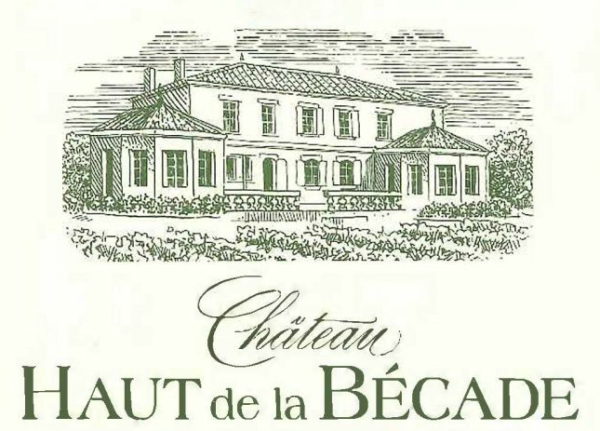
The Estate
Château Haut de la Bécade is a family-owned estate that has been making wine for several generations. Pauillac is a special appellation in the Haut-Medoc region of Bordeaux that makes highly sought after wines because of their balance, finesse, and the ability to age gracefully. The estate has been owned by the Rainaud family since 1933 and is located next to the most famous Chateaux in Pauillac including Chateau Lynch Bages, Pichon Baron, and Pichon Lalande de Comtesse.

Château Haut de la Becade Pauillac
Location: Situated between Chateau Latour and Chateau Lynch-Bages, at the top of a hill 11 meters above sea level (highest point in Pauillac, same height as Château Mouton Rothschild).
Production Area: 7 hectares
Average Age of Vines: 30 years old
Soil: Clay and limestone
Grape Varieties: 70% Cabernet Sauvignon, 25% Merlot, 5% Cabernet Franc
Harvest: Manual
Vinification: Fermentation for 3 weeks at a temperature of 28-30° C.
Aging: 18-20 months in French oak barrels. Fining with egg whites.
Annual Production: 55 hl/ha
Tasting Notes: Displays classic Pauillac aromas of lovely cassis and gravelly stone. Dark violet in color expressing a youthful hue. The medium acidity reflects its ability to continue to age with a backbone. This medium to full-bodied wine shows good clay and mineral-granite character along the length of the palate; while being encased in red currant and violet essence. This wine will continue to get better over the next 10 years.
Serving Temperature: 16-18 °C
Château Haut Nivelle
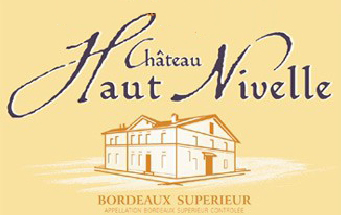
The Estate
Château Haut Nivelle is owned by Vignobles Le Pottier. Le Pottier’s family settled in 1979 on this bare property which had suffered from war and crisis from the first half of the 20th century. After long reflection and much hard work, the first vineyards were planted in 1986.

Bordeaux Supérieur Cuvée Prestige
Location: Château Haut Nivelle is situated on sunny slopes on the border of the Saint Emilion appellation. The vines are planted to the east of the Gironde and 55 kilometers from Bordeaux.
Soil: Chalky clay
Production Area: 12 ha
Annual Production: Close to 150,000 bottles
Grape Varieties: 70% Merlot, 30% Cabernet Sauvignon
Vinification: Modern facilities with temperature controlled stainless steel vats. Fermentation lasts between 3 to 5 weeks using micro-oxygenation to soften the wine. Aging takes place in cement vats.
Tasting Notes: Dark red color, aromatic and complex nose composed of dark fruit (blueberries, blackberries) and soft spices. Round mouth feel with thick, mature, and supple tannins with a silky length.
Château Haut Pasquet
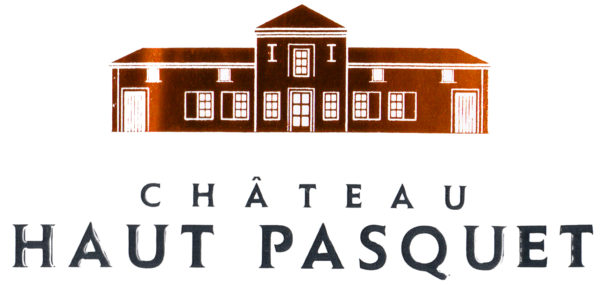
The Estate
For over 2 centuries, the Dubourg vineyards have been family-owned. Each generation has had a hand in the evolution of the estate, from adding to the acreage, to expanding the marketing campaign. In the late 1960s, Nadine and Bernard Dubourg dramatically changed the landscape of the estate by introducing land from the appellations of Sauternes and Saint-Émilion.

Chateau Haut-Pasquet Bordeaux Blanc
Location: The vineyards are situated in the heart of Bordeaux, near the small village of Éscoussans. They lie on southwest-facing slopes on the right bank of the Garonne river.
Production Area: 83 hectares
Average Age of the Vines: 20 years old
Annual Yield: 4,000 hectoliters/465,000 bottles
Varietal Blend: 100% Sauvignon Blanc
Vinification: The juice remains in contact with the skin contact for one night, followed by cold maceration for 5 days. Traditional vinification in stainless steel, temperature-controlled vats.
Aging: On the fine lees with stirring of the lees
Tasting Notes: Vibrant, pale yellow color with a nose of citrus fruit and white flowers. This Bordeaux Blanc offers good balance and elegant mouth feel; there are hints of grapefruit complemented by the bready notes from the lees.
Château Haut-Bages-Libéral (Biodynamic)
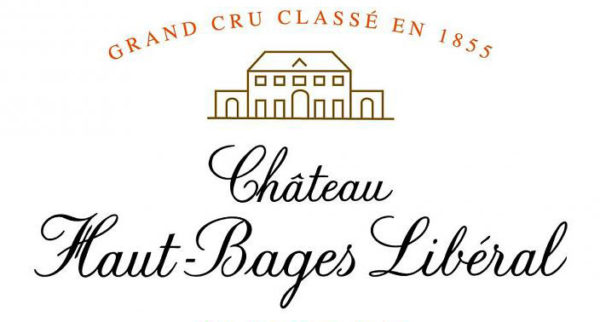
The Estate
The name of Haut‐Bages Libéral is derived from the Libéral family, who owned the property in the early 18th century. Passing the estate from father to son, they sold their harvest to the Netherlands and Belgium. Over time, the owners acquired some of the best terroir in Pauillac, expanding half of their vineyards to abut the estates of Château Latour and Château Pichon Baron (on the heights of the locality Bages, a large plateau in the south of Pauillac). Haut‐Bages Libéral was classified as 5th Growth in 1855.
In 1960, the Cruse family, owners of Château Pontet Canet, purchased the property. They would launch an extensive program of replanting the vineyard. However, it was in 1983 with the arrival of the Villars family that Château Haut‐Bages Libéral really recovered its former glory. Today, the property is run by Claire Villars‐Lurton. She undertook an overhaul of the wine making and directs the vineyard management towards sustainable viticulture.
The estate has been certified organic since 2019 and biodynamic since 2021.
Owner: Claire Villars Lurton
Production Manager: Thomas Bontemps
Wine Making Consultant: Eric Boissenot

Château Haut-Bages Libéral
Production Area: 30 hectares
Soil: Deep Quaternary gravel on limestone‐clay substrate
Grape Varieties: Cabernet Sauvignon, Merlot
Average Age of the Vines: 35 years old
Plantation Density: 10,000 plants/ha
Average Yield: 650 g/plant
Growing: Traditional integrated wine growing management
Harvest: Hand picking
Vinification: Traditional in stainless and concrete vats, whose volumes are proportional to the plots. Fermentation on the skins lasts 18 to 24 days.
Aging: In oak barrels for 16 months (40% new oak)
Cellaring Potential: 5-30 years
Tasting Notes: The nose is complex with notes of cassis, smoky and a hint of cedar. The mouth is also fruity with a slightly spicy touch and show an admirable roundness. An expressive, voluptuous wine with fine, freshness, and a beautiful aromatic persistence.

Le Haut-Médoc de Haut-Bages Libéral
Overview: The Second Wine of the estate is Le Haut-Medoc de Haut-Bages Libéral. This wine is produced using all the same facilities and methods as the First Wine.
Production Area: 8 hectares
Soil: Clay and limestone
Grape Varieties: 60% Cabernet Sauvignon, 40% Merlot
Average Age of the Vines: 20 years
Plantation Density: 6,500 plants/ha
Average Yield: 800 g/plant
Vines: Traditional and sustainable wine-growing
Harvest: Mechanical harvest with integrated sorting system and sorting table
Vinification: Traditional. In thermo-regulated stainless steel vats. Fermentation on skins for 18 to 24 days
Aging: 12 months in oak barrels
Production: 28,000 bottles
Cellaring Potential: 1 to 7 years

Ceres Haut-Médoc
Overview: CERES 2020 is the first organic, natural wine without added sulfur produced by a Grand Cru Classé in 1855 in Pauillac (also in conversion to biodynamic). Named after the Roman goddess of agriculture and fertility, this cuvée comes from a plot managed in agroecology and agroforestry.
Signed François Houtin, renowned landscape artist, the label of the CERES cuvée is in the image of this organic, lively and dazzling wine. It celebrates the vine in its original state, climbing along a resilient old ash tree.
Soil: Clay-limestone
Grape Varieties: 100% Merlot
Viticulture: 8 hectares of one single plot located on the hamlet of Vertheuil, in Pauillac North.
Vinification: Maceration with the addition of neutral gas to stimulate gentle movements. Pumping over one volume/day. 24 days of maceration. Vertical pressing Azote inerting during transfers to protect musts from oxidation. No added sulphites.
Aging: 6 months in concrete vats
Production: 20,000 bottles
Serving Temperature: 16-17°C
Tasting Notes: A fruity wine with floral notes on the nose and on the palate. Supple tannins with a fresh, chalky structure and nice acidity over the length.
Cellaring: Consume immediately or within 2-3 years depending on storage conditions.
Château Haut-Bailly

The Estate
Just a stone’s throw away from the city of Bordeaux, Château Haut-Bailly is one of the most prestigious Cru Classé of Graves. The 30 hectare (74 acre) estate sits majestically at the heart of the Graves region on the left bank of the river Garonne.

Château Haut-Bailly Pessac-Léognan Grand Cru Classé
Owner: Robert G. Wilmers
Appellation: Pessac Léognan
Location: Léognan
Soil: Tertiary Pyrenean slipped sand and gravel over faluns subsoil
Age of the Vineyard: 35 years (15% very old vines: 90 years)
Production Area: 30 ha (69 acres)
Annual Production: 160,000 bottles (all wines)
Grape Varieties: Cabernet Sauvignon 64%, Merlot 30%, Cabernet Franc 6%
Harvest: Manual
Vinification: Vinification in stainless steel tanks and concrete vats which are all thermo regulated. Vatting lasts 3 weeks.
Aging: 16 months in barrels (50-65% new barrels)
Tasting Notes: This wine has a distinctive style that harmoniously combines classicism with modernity, elegance and softness with structure. Elegance and finesse are the secret of its charm, giving it a character that is aristocratic, rich, and extraordinarily soft in spite of a high proportion of Cabernet. Haut-Bailly has great aging potential and consistently wins praise from experts who agree that it offers complexity and a richness that is neither aggressive nor ostentatious.
2012 Reviews: “Well-stuffed, with thick and muscular brambly structure that easily supports the core of macerated black currant, fig and boysenberry fruit flavors. A tarry edge coats the finish. More backwards than most of its peers at this early stage, but all the elements are in place. Best from 2018 through 2027.” – 93pts, Wine Spectator
“Very firm and closed up, this wine is a tough proposition at the moment. It has the weight to develop well along with richness. Acidity, sweet fruits and concentrated tannins will all come through strongly as the wine matures. Drink from 2020. Cellar Selection.” – 94pts, Wine Enthusiast
“The 2012 Haut Bailly is a brilliant wine for the vintage. It has a very intense bouquet with scents of blackberry, bilberry, cedar and a touch of pencil lead. This is very well defined and focused. The palate is medium-bodied with quite firm tannin, certainly one of the most structured Pessac-Léognan wines that I have encountered, yet it is struck through with wonderful balance and focus. It tightens up a little on the finish, a 2012 built for long-term drinking pleasure, and as such, I would afford it five or six more years in bottle if wishing to experience this in full flight.” – 94pts, Wine Advocate



